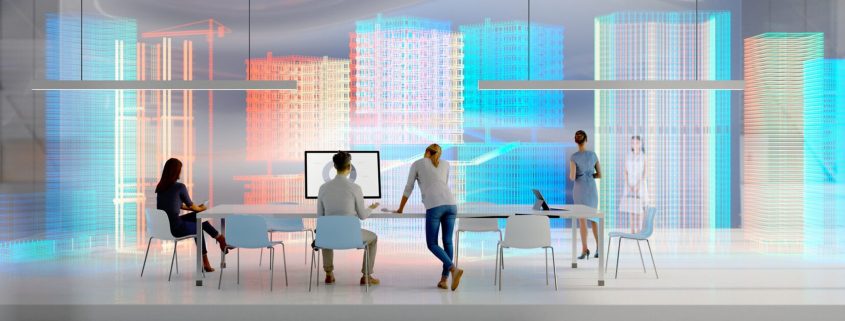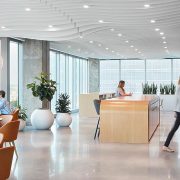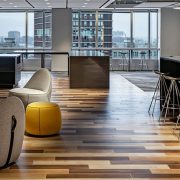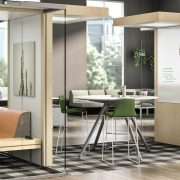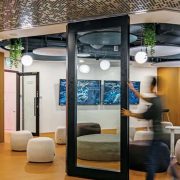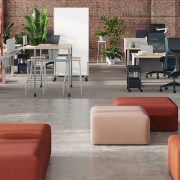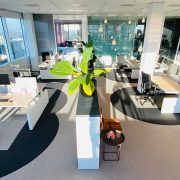Inclusive Work Design For Flexible Workers
Inclusive work design for flexible workers is the next positive gain in the return to work. More than half of US workers are opting in for the hybrid work model. Splitting time between working from home and working in the office can become a formidable asset in the return to work. So how do you design to accommodate an inclusive work environment?
Many workers want to return to the workplace while keeping the benefits of flexibility and access to privacy they’ve enjoyed while working from home. There are a lot of positions that are not mandatory to the public-facing sector of a business that can benefit greatly from the adaptability of flexible work. Incorporating inclusive design strategies into spaces can empower your team with a more balanced work experience. A blended solution can result in a better strategy and work experience for everyone.
What Is Inclusive Work Design?
Inclusive work design is a commitment that gives equal recognition to different styles of working, being mindful that the way your employees engage with work, depends on a range of differing expectations, that reflect a variety of personality styles, cultural preferences, and professional needs.
Its roots began with the development of Universal Design. Universal design means developing physical, learning, and work environments so that they are usable by a wide range of people, regardless of age, size, or disability status. Adding flexible workspaces to that model and figuring out how to use the square footage you have left over from displaced and flexible workers adds to the range of benefits instilled in inclusive design. The key principles of Universal Design as adapted by inclusivity include:
- Equitable use of the space, regardless of the person’s background and abilities
- Flexibility to accommodate a wide range of individual preferences and abilities
- Simple and intuitive use of space without assistance or help from someone else
- Assurance that flex spaces are antimicrobial and that they are cleaned between usage, and providing supplies for the user to feel comfortable, safe, and in control of it.
The Shift
Prior to the pandemic, flexible work principles were embedded to support family and personal needs which included offering remote work options, establishing core hours to allow employees flexibility during the workday, and creating a more inclusive holiday/cultural leave policy. In contemplating the objectives for a hybrid workspace, key goals were identified to work towards inclusive work design:
- Returning to the office with a sense of place and purpose: Clearly articulating why it is important for your teams to physically work together, including a focus on professional development through unstructured training and mentoring, and the ease of exchanging energy and connectedness through in-person collaboration.
- Celebrating the in-between moments of personal connection that build trust, spark creativity, and boost morale and creativity.
- Replacing time-intensive formalized virtual meetings with informal drop-in discussions and ad-hoc collaboration between teams. Suspending the calendar overload experienced during fully remote workdays to allow for more flexible interaction.
- Providing choice in where to work – both between home, office, satellite campuses, and workplace environment. Ensure that every employee feels engaged whether they have chosen to work in the office or remotely on that particular day.
The Merge
Although there have been many successes, the need to continue to explore what needs weren’t being met is ongoing. Continued experimentation focuses on improvements for lessons learned. What’s lies ahead includes:
- Elevated technological re-integration to support a fully functional hybrid workplace experience. Shifting into the optimal collaborative environment for a hybrid office requires careful consideration of the overall design of the office space to allow for simultaneous interaction without disruption or interference. These considerations will heighten collaboration:
- Optimization of zoom-location aesthetics in huddle and open collaborative areas
- Attention to office acoustics, lighting, and sensory
- Audio + video upgrades that may include LED walls
- Easily adaptable technology for offsite connectivity
- More cohesive workstream for proper channels of communications. What communication streams warrant a Zoom meeting vs an email, Teams chat, or all-office email?
- Reconfiguring collaborative spaces to support hybrid meeting settings where everyone is on individual laptops and more visible to remote team members. Ensuring that staff working remotely feel more inclusive in their dialog with in-office colleagues while keeping cleanliness and safety in check:
- Using personal devices within conference rooms rather than a camera view at the end of a table
- Using online cloud services like Slack to integrate remote + office teams
Flexing Your Office Space Usage
Because not everyone’s work-from-home experience looks the same—some thrived, some did not. Upgrading your office design from less traditional to more resimercial styling will create a more low-key casual vibe. Comfortable chairs and sofas, cafe seating, and flexible huddle spaces will be very important for the return to work.
For some families with kids and/or aging relatives at home trading newly won flexibility for a long commute ending in a lackluster office will just not be happening. People who live alone may have been itching to come back to the office, but frustrated by not knowing who they’ll see there, or when.
Just as the work-from-home experience was challenging, the return to work with obligations that changed during the transition may be just as difficult. Inclusive design should recognize how these diverging experiences will shape what different members of the same team may want in the future.
The way to achieve this is the change minds, not just space, by defining an ecosystem!
Actively listen to and prioritize real people’s needs by not generalizing solutions. By doing so, organizations can discover—and bring to life—a rich work ecosystem where all employees thrive. Workplace transformation is inevitable, how we choose to shape and adapt to it can take many forms:
- Put your unused office space to work as flex open coworking space for open use
- Make spaces more approachable & inviting to people from every class and socioeconomic background
- Keep cleaning supplies accessible so they can control the safety of the area where they choose to work
- Create a hub & spoke system by teaming up with related businesses to create regional coworking access
- Brainstorm creative ways to help your firm’s values flourish with how your teams work together apart
- Pay attention to how all levels of your team solve these problems, you might find a rising management star!
- Don’t lose sight of the strides people make offsite! Acknowledge and reward them!!!
When you enter into your planning process, plan around your people. Include them in the process. You will not only discover what needs to change—you’ll foster a happier, more invested workforce that will remain committed and engaged remotely or in-house. Our design team can get you on track quickly with troubleshooting concepts and collaborative design solutions.
 INSPIRED WORKSPACES: Our goal is to partner with you on your business journey to help you find viable solutions that navigate current and future trends, immediate needs, and changes that require immediate attention within your workplace. Contact us at 512-448-3769 or experts@officefurniturenow.com
INSPIRED WORKSPACES: Our goal is to partner with you on your business journey to help you find viable solutions that navigate current and future trends, immediate needs, and changes that require immediate attention within your workplace. Contact us at 512-448-3769 or experts@officefurniturenow.com

